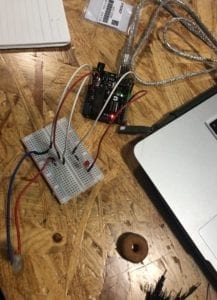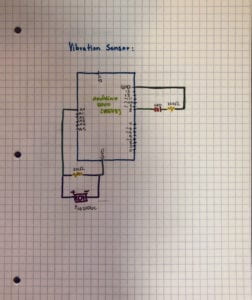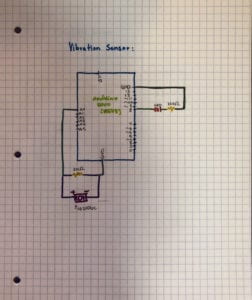Vibration Sensor
- Breadboard to Arduino:
- We used a piezo disk sensor that senses vibration and connected it to the power the Arduino and ground. then connecting the piezo disk sensor to a 1 mega-ohm resistor connecting that to the ground of the Arduino. We then connected a LED output 8 and a 220-ohm resistor into the output ground. It did not work at first because we had the polarity reversed for the LED then we fixed it and it worked and when we hit the plate the light lit up.


https://youtu.be/oWiOaBwKTd0
- Code:
- Arduino>File>Examples>0.6Sensors>Knock
code from the Arduino website.
Moisture Sensor
- Breadboard:
- The sensor was slightly more difficult to make. First, we connected the moisture sensor first the ground to the ground of the Arduino, The Vcc (the red wire) to the power of the Arduino, and lastly the yellow wire of the moisture sensor to A0 on the Arduino. We kept the light that we used for the circuit before.
- Code:
- The coding was also slightly tricky. Off of the website Seeedstudio we had initially copied and pasted the first example of coding :
int sensorPin = A0;
int sensorValue = 0;
void setup() {
Serial.begin(9600); }
void loop() { // read the value from the sensor:
sensorValue = analogRead(sensorPin);
Serial.print(“Moisture = “ );
Serial.println(sensorValue);
delay(1000);
}
But when we were touching the moister sensor we notice the light was turning on and off; however, instead of showing the moisture level it was saying knock. It turned out that the coding from the last sensor was still lingering so we had to go into the coding and add the action of the light.
int sensorPin = A0;
int sensorValue = 0;
int ledPin = 8;
void setup() {
Serial.begin(9600);
pinMode(ledPin, OUTPUT);
}
void loop() {
// read the value from the sensor:
sensorValue = analogRead(sensorPin);
Serial.print(“Moisture = “ );
Serial.println(sensorValue);
delay(1000);
(sensorValue > 90)
{
digitalWrite(ledPin, HIGH);
}
else
{
digitalWrite(ledPin, LOW);
}
After adding the coding for the LED the instead of knocking the computer was reading the moisture.

https://youtu.be/08jdgCUSD5g
Question one:
What did you intend to assemble in the recitation exercise? If your sensor/actuator combination were to be used for pragmatic purposes, who would use it, why would they use it, and how could it be used?
Answer one:
I personally intended to find out what the vibration sensor did to see if it was the sensor I was looking for, for my video game idea. And it was? I asked questions and was told that if I were going to use one to use a more sensitive one and that if I were going to put it on the floor I should instead use some sort of board so the vibration could sense better the vibration caused by jumping or stomping. A vibration sensor realistically can be used to measure the vibrations of a machine to check whether the machine is healthy or not. Maybe a mechanic would use it on a car if an own noticed anything a little off. It might be used or already be programmed in the car and they somehow measure it and see if the vibrations are off from the usual and diagnose it an unhealthy car.
Question two:
Code is often compared to following a recipe or tutorial. Why do you think that is?
Answer two:
This is totally true. I think it more closely aligns with a baking recipe because with baking every ingredient must be mixed and measured to perfection. Code is the same way because if you get a single missed letter, spelling. or capitalization wrong your cake is coming out wonky and the texture completely wrong. There is also the box cake mix of code where you copy and paste code too which you can not possibly mess up, but sometimes it does not come out right or you need to add something to make the code work for a particular situation ( like we did in the moisture one).
Question three:
In Language of New Media, Manovich describes the influence of computers on new media. In what ways do you believe the computer influences our human behaviors?
Answer three:
It may be too soon to tell, but as gerneration Z becomes adults the changes in behavior may be more evident. As a generation that grew up with computers and the internet the tendencies to think and generate ideas can be similar to a computer. From Language of New Media Manovich explains periodic updates as the updating of new software. The rush of new updates and software that bombard us each day the need to be up to date can be an alteration to human behavior. The constant need to be connected to the newest thing or the new capability to create in even more detail to the average person (‘Photoshop, “Microsoft Word”) has changed human behavior to not only be apart of the next big thing but to also make it.